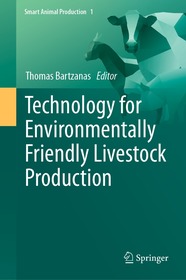
Technology for Environmentally Friendly Livestock Production
Series: Smart Animal Production; 1;
- Publisher's listprice EUR 181.89
-
75 438 Ft (71 846 Ft + 5% VAT)
The price is estimated because at the time of ordering we do not know what conversion rates will apply to HUF / product currency when the book arrives. In case HUF is weaker, the price increases slightly, in case HUF is stronger, the price goes lower slightly.
- Discount 12% (cc. 9 053 Ft off)
- Discounted price 66 386 Ft (63 224 Ft + 5% VAT)
Discounted price for customers subscribed to our weekly newsletter.
Subcribe now and take benefit of a favourable price.
Subscribe
Subcribe now and take benefit of a favourable price.
Subscribe
75 438 Ft

Availability
printed on demand
Why don't you give exact delivery time?
Delivery time is estimated on our previous experiences. We give estimations only, because we order from outside Hungary, and the delivery time mainly depends on how quickly the publisher supplies the book. Faster or slower deliveries both happen, but we do our best to supply as quickly as possible.
Product details:
- Edition number 2023
- Publisher Springer International Publishing
- Date of Publication 15 April 2023
- Number of Volumes 1 pieces, Book
- ISBN 9783031197291
- Binding Hardback
- No. of pages308 pages
- Size 235x155 mm
- Weight 641 g
- Language English
- Illustrations VIII, 308 p. 1 illus. Illustrations, black & white 524
Categories
Anthropology
Zoology
Anatomy, embryology, histology
Veterinary science
Agriculture in general
Environmental sciences
Ecology
Environmental protection
Environmental sciences in general
Anthropology (charity campaign)
Zoology (charity campaign)
Anatomy, embryology, histology (charity campaign)
Veterinary science (charity campaign)
Agriculture in general (charity campaign)
Environmental sciences (charity campaign)
Ecology (charity campaign)
Environmental protection (charity campaign)
Environmental sciences in general (charity campaign)
Long description:
This volume compiles state-of-the-art scientific knowledge on the technologies that are used to quantify and reduce the environmental impact of livestock production in the cattle, pig and poultry industries. It makes a serious statement about how such technology can contribute to the sustainability of the livestock industry in the future.
As the global livestock sector is growing, modern farm animal production is increasingly regarded as a source of solid, liquid, gaseous and dust emissions, which can be both nuisance and environmentally harmful. In light of hardening regulations and social pressure, there is increasing interest in scientific research on air pollution and emissions from livestock operations.
The present chapters focus on methodology improvement, harmonization of measurements, and modeling aspects. Key aspects, such as renewable energy sources, nutritional approaches to reduce enteric methane emissions, technical options for manure management, and the use of sensors, are covered. By sharing good practices, this book is a valuable reference for a diverse readership. Experts across the veterinary and animal sciences, agricultural engineering, the food industry and sustainability research will benefit from the findings.




